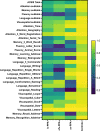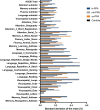Utility of the Addenbrooke's Cognitive Examination III online calculator to differentiate the primary progressive aphasia variants
- PMID: 35912134
- PMCID: PMC9336588
- DOI: 10.1093/braincomms/fcac161
Utility of the Addenbrooke's Cognitive Examination III online calculator to differentiate the primary progressive aphasia variants
Abstract
The Addenbrooke's Cognitive Examination III is a brief cognitive screening tool that is widely used for the detection and monitoring of dementia. Recent findings suggest that the three variants of primary progressive aphasia can be distinguished based on their distinct profiles on the five subdomain scores of this test. Here, we investigated the utility of the Addenbrooke's Cognitive Examination III to differentiate the primary progressive aphasia variants based on their item-by-item performance profiles on this test. From these results, we created an interactive primary progressive aphasia Addenbrooke's Cognitive Examination III calculator which predicts the variant based on a patient's unique item-by-item profile. Twenty-eight logopenic variant, 25 non-fluent variant and 37 semantic variant primary progressive aphasia patients and 104 healthy controls completed the Addenbrooke's Cognitive Examination III at first clinical presentation. Multinomial regression analyses were conducted to establish performance profiles among groups, and R Shiny from RStudio was used to create the interactive Addenbrooke's Cognitive Examination III diagnostic calculator. To verify its accuracy, probability values of the regression model were derived based on a 5-fold cross-validation of cases. The calculator's accuracy was then verified in an independent sample of 17 logopenic, 19 non-fluent and 13 semantic variant primary progressive aphasia patients and 68 Alzheimer's disease patients who had completed the Addenbrooke's Cognitive Examination III (or an older version of this test: Revised) and had in vivo amyloid-PET imaging and/or brain autopsy pathological confirmation. Cross-validation of cases in the calculator model revealed different rates of sensitivity in classifying variants: semantic = 100%, non-fluent = 80.6% and logopenic = 79.9%; healthy controls were distinguished from primary progressive aphasia patients with 100% sensitivity. Verification of in vivo amyloid and/or autopsy-confirmed patients showed that the calculator correctly classified 10/13 (77%) semantic variant, 3/19 (16%) non-fluent variant and 4/17 (24%) logopenic variant patients. Importantly, for patients who were not classified, diagnostic probability values mostly pointed toward the correct clinical diagnosis. Furthermore, misclassified diagnoses of the primary progressive aphasia cohort were rare (1/49; 2%). Although 22 of the 68 Alzheimer's disease patients (32%) were misclassified with primary progressive aphasia, 19/22 were misclassified with the logopenic variant (i.e. falling within the same neuropathological entity). The Addenbrooke's Cognitive Examination III primary progressive aphasia diagnostic calculator demonstrates sound accuracy in differentiating the variants based on an item-by-item Addenbrooke's Cognitive Examination III profile. This calculator represents a new frontier in using data-driven approaches to differentiate the primary progressive aphasia variants.
Keywords: Alzheimer’s disease; cognitive assessment; data-driven classification; dementia screening; frontotemporal dementia.
© The Author(s) 2022. Published by Oxford University Press on behalf of the Guarantors of Brain.
Figures




References
LinkOut - more resources
Full Text Sources
